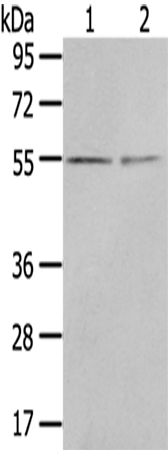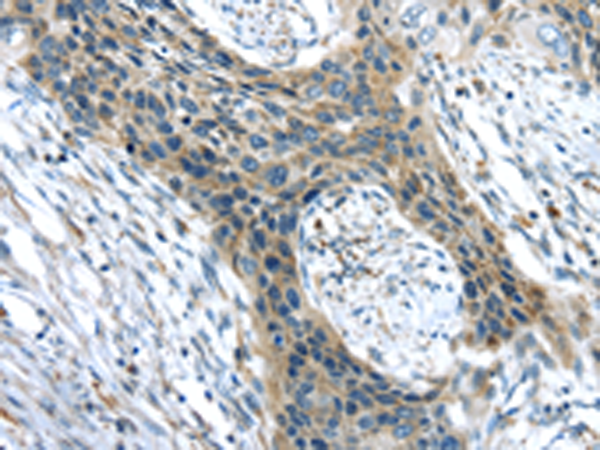

| WB | 咨询技术 | Human,Mouse,Rat |
| IF | 咨询技术 | Human,Mouse,Rat |
| IHC | 1/25-1/100 | Human,Mouse,Rat |
| ICC | 技术咨询 | Human,Mouse,Rat |
| FCM | 咨询技术 | Human,Mouse,Rat |
| Elisa | 1/1000-1/2000 | Human,Mouse,Rat |
| Aliases | CHL; MGC1; MGCN; VOPT; NRLN1; dA141H5.1 |
| WB Predicted band size | 51 kDa |
| Host/Isotype | Rabbit IgG |
| Antibody Type | Primary antibody |
| Storage | Store at 4°C short term. Aliquot and store at -20°C long term. Avoid freeze/thaw cycles. |
| Species Reactivity | Human, Mouse, Rat |
| Immunogen | Synthetic peptide of human CHRDL1 |
| Formulation | Purified antibody in PBS with 0.05% sodium azide and 50% glycerol. |
+ +
以下是3篇涉及CHRDL1抗体的代表性文献及其摘要概括:
---
1. **文献名称**: "CHRDL1 antagonizes BMP signaling in glioblastoma"
**作者**: Roth et al. (2016)
**摘要**: 研究报道CHRDL1在胶质母细胞瘤中通过分泌性蛋白形式抑制BMP4信号通路,利用特异性抗体证实其高表达与肿瘤细胞侵袭性降低相关,提示其作为潜在治疗靶点。
---
2. **文献名称**: "Monoclonal antibody targeting CHRDL1 promotes axon regeneration"
**作者**: Zhang et al. (2020)
**摘要**: 开发了一种靶向CHRDL1的单克隆抗体,实验显示其能阻断CHRDL1与BMP受体的结合,在脊髓损伤模型中促进神经元轴突再生,验证了抗体在神经修复中的治疗潜力。
---
3. **文献名称**: "CHRDL1 as a biomarker in breast cancer: Antibody-based detection"
**作者**: Lee et al. (2019)
**摘要**: 通过免疫组化和Western blot分析,利用CHRDL1抗体发现其在乳腺癌组织中表达下调,与BMP信号异常激活及患者预后不良相关,提出其作为诊断标志物的可能性。
---
**备注**:若需获取完整文献,建议通过PubMed或Google Scholar以关键词“CHRDL1 antibody” + “BMP”/“cancer”/“therapeutic”进一步筛选近5年研究。部分研究可能侧重基因功能而非抗体开发,需结合摘要判断相关性。
The CHRDL1 (Chordin-like 1) antibody is a tool used to detect and study the CHRDL1 protein, a secreted glycoprotein belonging to the Chordin family. CHRDL1 functions as an antagonist of bone morphogenetic proteins (BMPs), particularly BMP4. by binding to them and preventing interactions with their receptors. This modulation of BMP signaling is critical in developmental processes, including neurogenesis, osteogenesis, and ocular development. In the eye, CHRDL1 is highly expressed in the retina and regulates aqueous humor dynamics, linking it to glaucoma pathogenesis. Dysregulation of CHRDL1 has also been implicated in cancer, where it may act as a tumor suppressor by inhibiting BMP-driven cell proliferation and metastasis.
CHRDL1 antibodies are widely used in research applications such as Western blotting, immunohistochemistry, and ELISA to quantify protein expression, map tissue distribution, or assess functional interactions in developmental and disease models. Structurally, CHRDL1 contains conserved cysteine-rich domains essential for BMP binding, and specific antibodies often target these epitopes. Recent studies highlight its potential as a biomarker in diseases like glioblastoma and age-related macular degeneration. Research using CHRDL1 antibodies continues to explore its therapeutic relevance, particularly in conditions involving BMP pathway dysregulation.
×